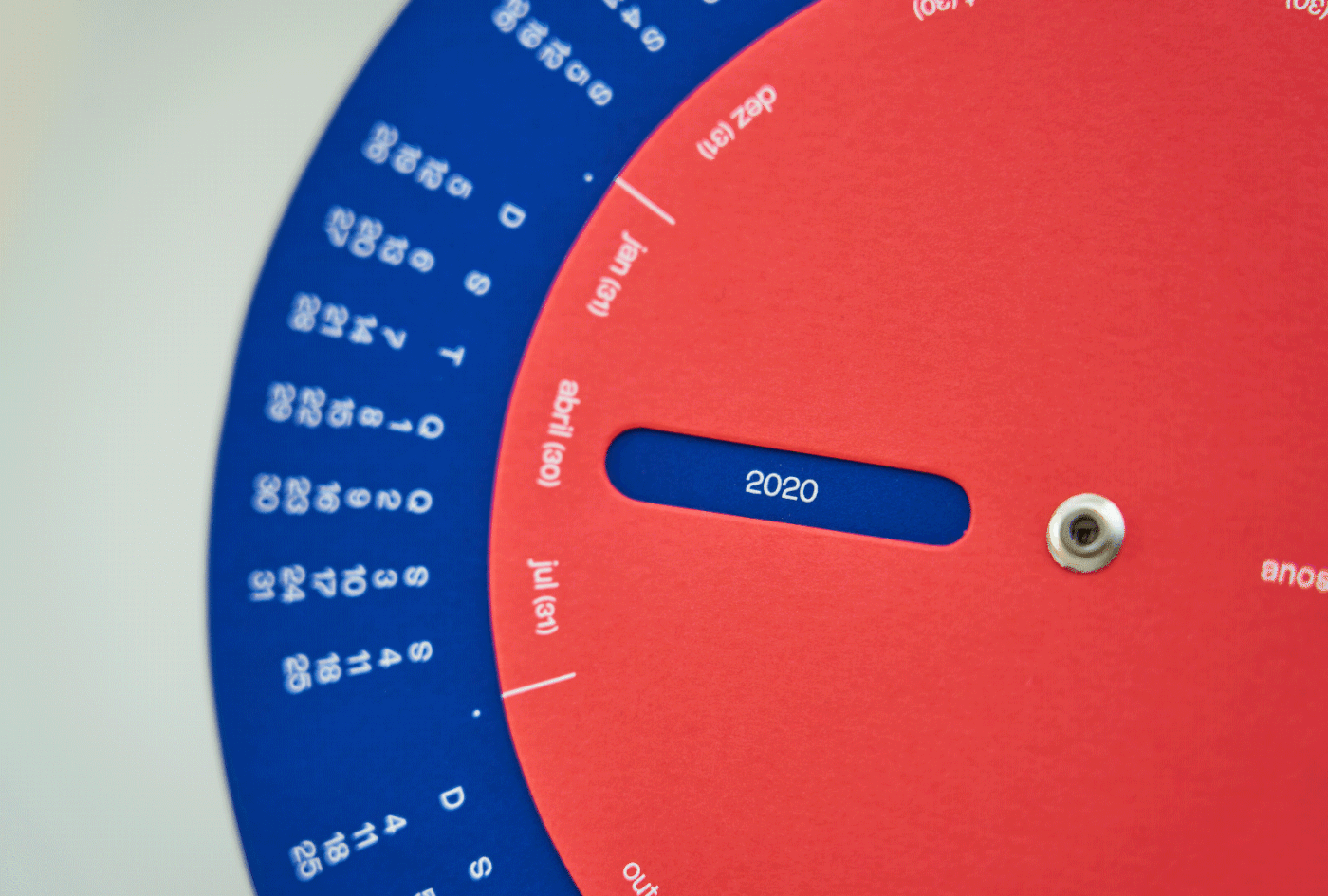
PT
Esta é uma reedição dos antigos calendários perpétuos criados na Idade Média. O calendário mais próximo de como o conhecemos foi instituído por Júlio César no dia 1º de janeiro de 45 a.C. Antes dele, o calendário romano apresentava 355 dias e se baseava nos ciclos lunares. O imperador, copiando o exemplo egípcio, trocou a lua pelo sol como referência astronômica e deu ao ano 365 dias e 6 horas, ou seja, 365 e 1/4 de dia, com a fração sendo considerada através de um sistema cíclico de três anos de 365 dias seguidos por um ano bissexto de 366 dias. Esse modelo procurava corrigir uma falha que fazia o ano o lunar correr mais rápido do que o ano solar — o que atrapalhava os agricultores que precisavam de uma referência precisa para guiá-los através das estações. Porém, esse calendário também continha falhas matemáticas: um erro de um dia inteiro a cada 128 anos. Séculos depois, em 5 de outubro de 1582, o Vaticano colocou em vigor um novo calendário, que ganhou o nome do papa Gregório XIII. O ano agora passava a ter exatos 365 dias, 5 horas, 48 minutos e 20 segundos. Para isso, foram suprimidos dez dias da vida de todos — o que causou revoltas por toda a Europa. Os últimos países a adotar o calendário gregoriano foram a Grécia em 1923 e a Turquia em 1926. É o calendário gregoriano que rege nosso tempo nos dias de hoje.
Esta é uma reedição dos antigos calendários perpétuos criados na Idade Média. O calendário mais próximo de como o conhecemos foi instituído por Júlio César no dia 1º de janeiro de 45 a.C. Antes dele, o calendário romano apresentava 355 dias e se baseava nos ciclos lunares. O imperador, copiando o exemplo egípcio, trocou a lua pelo sol como referência astronômica e deu ao ano 365 dias e 6 horas, ou seja, 365 e 1/4 de dia, com a fração sendo considerada através de um sistema cíclico de três anos de 365 dias seguidos por um ano bissexto de 366 dias. Esse modelo procurava corrigir uma falha que fazia o ano o lunar correr mais rápido do que o ano solar — o que atrapalhava os agricultores que precisavam de uma referência precisa para guiá-los através das estações. Porém, esse calendário também continha falhas matemáticas: um erro de um dia inteiro a cada 128 anos. Séculos depois, em 5 de outubro de 1582, o Vaticano colocou em vigor um novo calendário, que ganhou o nome do papa Gregório XIII. O ano agora passava a ter exatos 365 dias, 5 horas, 48 minutos e 20 segundos. Para isso, foram suprimidos dez dias da vida de todos — o que causou revoltas por toda a Europa. Os últimos países a adotar o calendário gregoriano foram a Grécia em 1923 e a Turquia em 1926. É o calendário gregoriano que rege nosso tempo nos dias de hoje.
EN
This is a reprint of the old perpetual calendars created in the Middle Ages. The calendar closest to how we know it was instituted by Julius Caesar on January 1, 45 BC. Before that, the Roman calendar had 355 days and was based on lunar cycles. The emperor, copying the Egyptian example, exchanged the moon for the sun as an astronomical reference and gave the year 365 days and 6 hours, that is, 365 and 1/4 of a day, with the fraction being considered through a three-year cyclic system 365 days followed by a leap year of 366 days. This model sought to correct a flaw that made the lunar year run faster than the solar year — which hampered farmers who needed a precise reference to guide them through the seasons. However, that calendar also contained mathematical flaws: a one-day error every 128 years. Centuries later, on October 5, 1582, the Vatican put in place a new calendar, which was named after Pope Gregory XIII. The year now had exactly 365 days, 5 hours, 48 minutes and 20 seconds. To this end, ten days of everyone's life were suppressed — which caused revolts across Europe. The last countries to adopt the Gregorian calendar were Greece in 1923 and Turkey in 1926. It is the Gregorian calendar that governs our time today.
This is a reprint of the old perpetual calendars created in the Middle Ages. The calendar closest to how we know it was instituted by Julius Caesar on January 1, 45 BC. Before that, the Roman calendar had 355 days and was based on lunar cycles. The emperor, copying the Egyptian example, exchanged the moon for the sun as an astronomical reference and gave the year 365 days and 6 hours, that is, 365 and 1/4 of a day, with the fraction being considered through a three-year cyclic system 365 days followed by a leap year of 366 days. This model sought to correct a flaw that made the lunar year run faster than the solar year — which hampered farmers who needed a precise reference to guide them through the seasons. However, that calendar also contained mathematical flaws: a one-day error every 128 years. Centuries later, on October 5, 1582, the Vatican put in place a new calendar, which was named after Pope Gregory XIII. The year now had exactly 365 days, 5 hours, 48 minutes and 20 seconds. To this end, ten days of everyone's life were suppressed — which caused revolts across Europe. The last countries to adopt the Gregorian calendar were Greece in 1923 and Turkey in 1926. It is the Gregorian calendar that governs our time today.
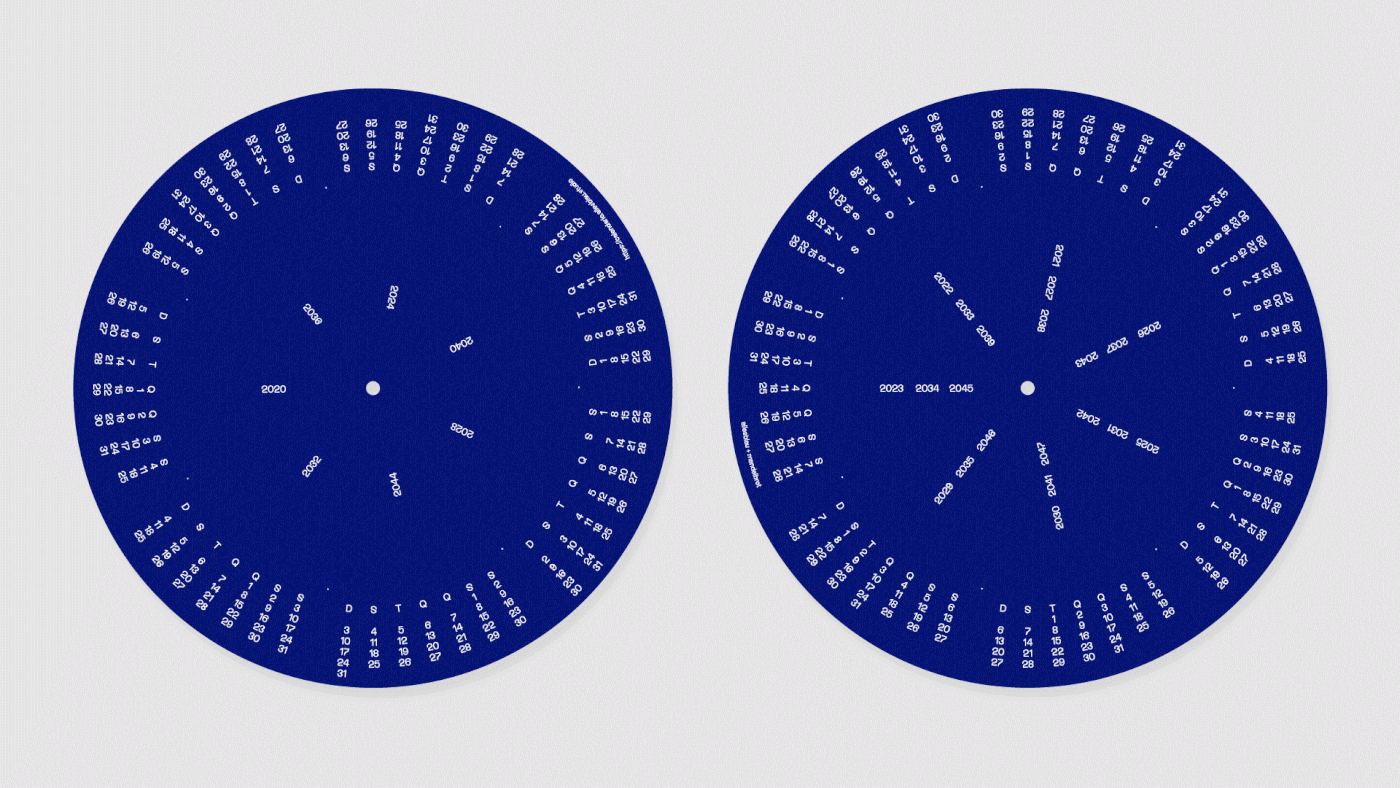
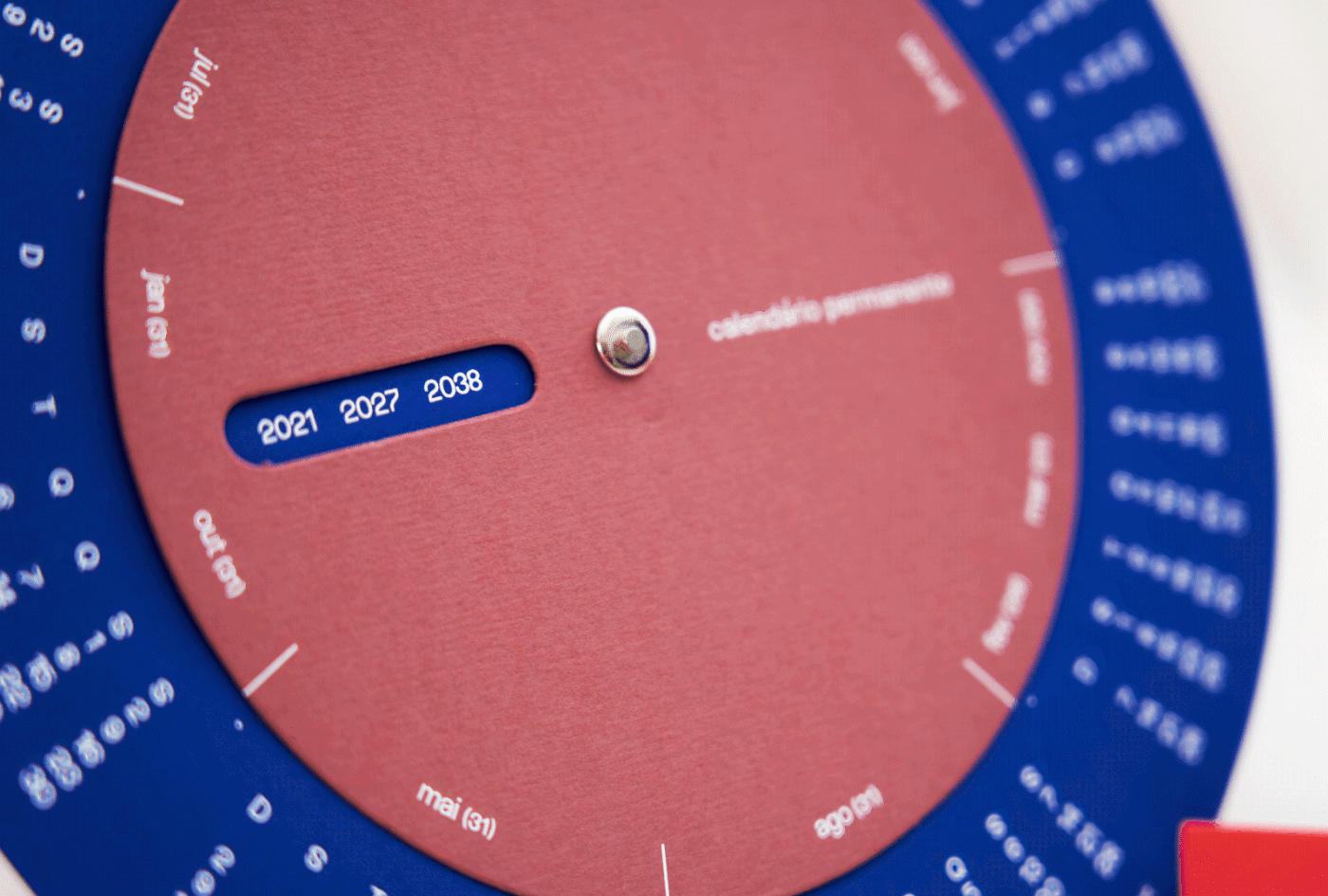
PT
Como funciona o Calendário Permanente?
O dispositivo funciona a partir da sobreposição dois planos: uma tabela com sete tipos de variações de meses (associados ao dia da semana com que começam) e um plano com os nomes dos meses em si. O calendário tem duas faces, uma para cada tipo de ano (normais e bissextos). Para manuseá-lo, basta escolher a face e rotacionar o disco menor até encontrar em sua fenda o ano a ser consultado. Assim, o disco menor nomeia os meses do disco maior e tem-se o calendário anual. Cobrimos um período de 28 anos (2020-2047), sendo 2020, 2024, 2028, 2032, 2036, 2040 e 2044 anos bissextos.
Sobre esses dois planos analógicos, inserimos uma camada de realidade aumentada, desenvolvida em parceria com a Mandelbrot. O aplicativo permite acessar dados temporais, afetivos e geográficos, atualizados em tempo real: um relógio virtual, a posição do sol em relação aos signos do zodíaco, a fase atual da lua e a previsão do tempo, que está associada a trechos de músicas, poesias e haicais.
O nosso Calendário Permanente reverencia o conhecimento tradicional, a ciência, a impressão sobre papel e a potência infinita da tecnologia. E, é claro, o tempo — este, sim, imperador de tudo e de todos.
EN
How does the Permanent Calendar work?
The device works from the overlapping two plans: a table with seven types of month variations (associated with the day of the week they start with) and a plan with the names of the months themselves. The calendar has two faces, one for each type of year (normal and leap). To handle it, just choose the face and rotate the smaller disc until you find the year to be consulted in its slot. Thus, the smaller disk names the months of the larger disk and there is the annual calendar. We cover a period of 28 years (2020-2047), with 2020, 2024, 2028, 2032, 2036, 2040 and 2044 leap years.
On these two analogical plans, we insert an augmented reality layer, developed in partnership with Mandelbrot. The application allows access to temporal, affective and geographical data, updated in real time: a virtual clock, the position of the sun in relation to the signs of the zodiac, the current phase of the moon and the weather forecast, which is associated with excerpts of music, poetry and haiku.
Our Permanent Calendar reveres traditional knowledge, science, printing on paper and the infinite power of technology. And, of course, time — this, yes, emperor of everything and everyone.


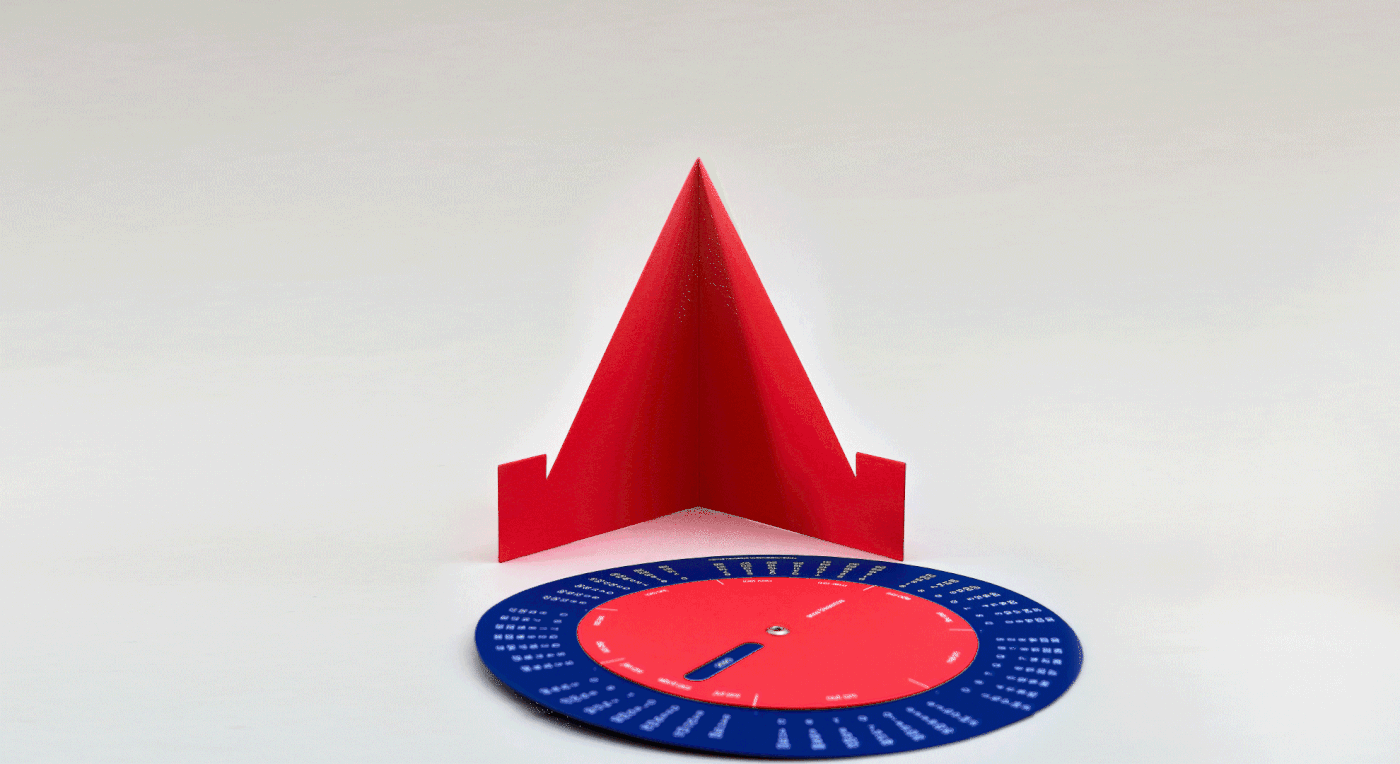
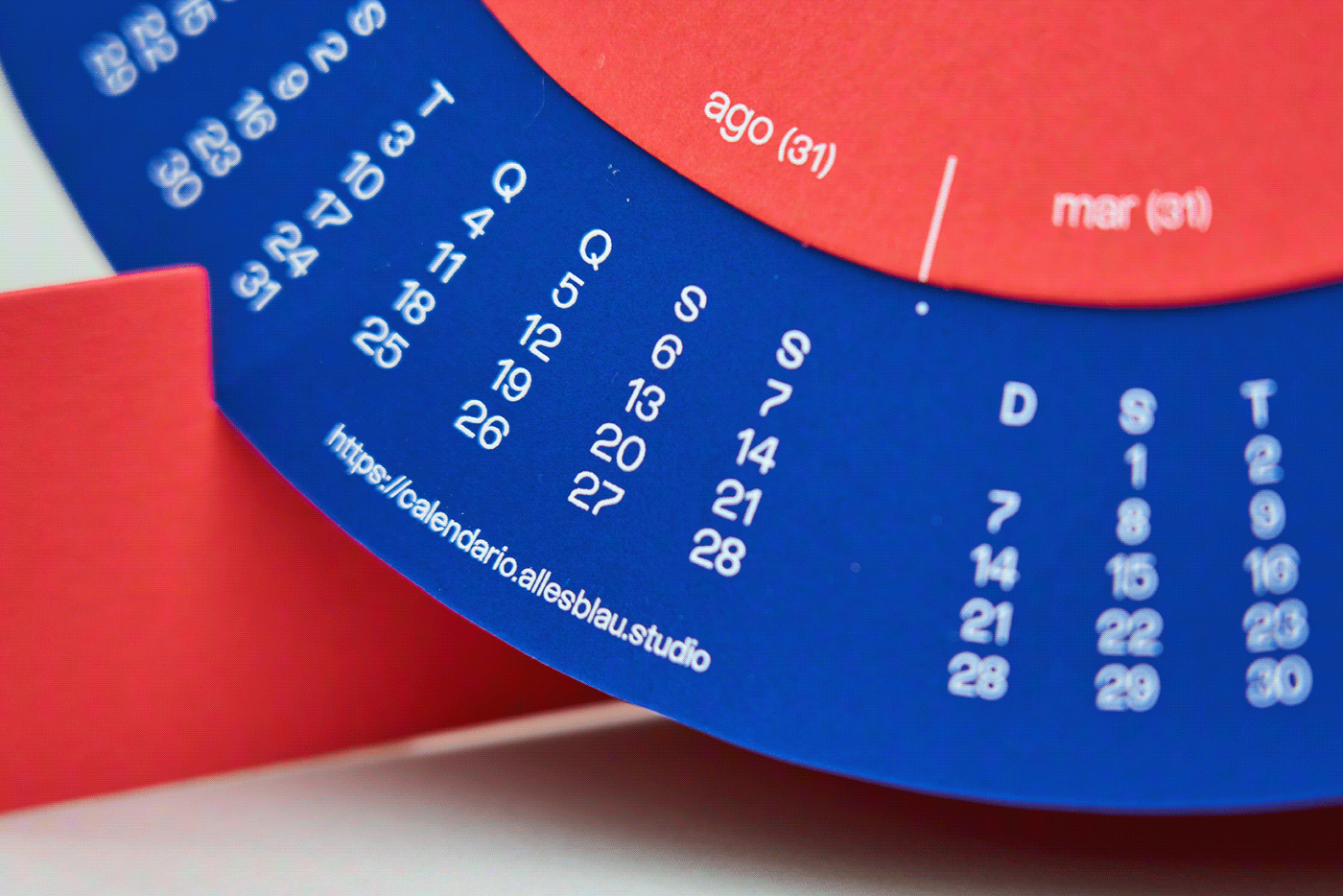













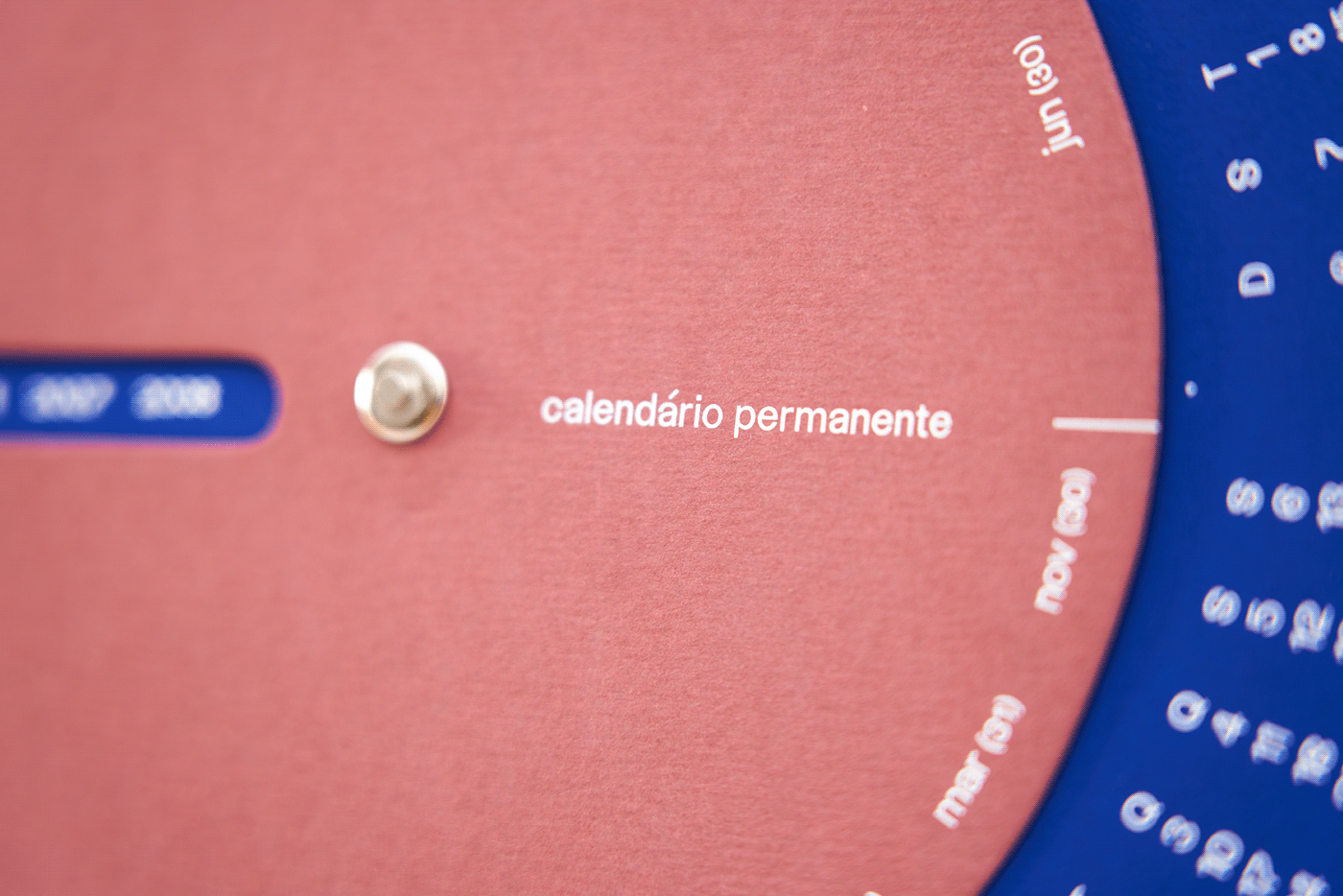
PROJETO GRÁFICO E DIREÇÃO DE ARTE [GRAPHIC PROJECT AND ART DIRECTION] Alles Blau
FOTOS [PHOTOS] Rodrigo Lins
PROGRAMAÇÃO [WEB DEVELOPING] Andrei Thomaz (mandelbrot)
TIPOGRAFIA [TIPOGRAPHY] Durango Kid, desenhada por Fabiano Procópio
PAPEIS [PAPER] Ardiron Blue, Keaycolor Rosebud e Coral
IMPRESSÃO [PRINT] Efeito Visual
AGRADECIMENTO [THANKS TO] André Viana
PAPEIS [PAPER] Ardiron Blue, Keaycolor Rosebud e Coral
IMPRESSÃO [PRINT] Efeito Visual
AGRADECIMENTO [THANKS TO] André Viana
____
Obrigada!
Thank you!
→ @allesblau.studio






